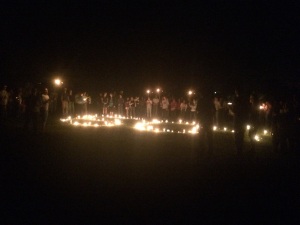It’s a rainy Saturday here in Southern Paraguay, and seeing as all I’m doing is sitting on my porch after lunch, drinking mate with my makeshift Termo (a Nalgene with a wool sock around it), I figured I’d update my fan club.
First of all, Latin America is nearing the end of Semana Santa (Holy Week), as Easter is tomorrow. In Paraguay, this generally just means a lot of prayer and even more food. At least in my neck of the woods, it appears as though each day of the week was devoted to making a certain traditional Paraguayan food, most notably Chipa on Ash Wednesday. Chipa is a corn flour baked good with a hard crusty outside and soft, slightly cheesy inside. When most commonly sold fresh and hot on long bus rides, I find it irresistable. When brought to my door by my nephews after sitting on the table for three days, easily usable to play hockey with, I find it resistable. Making the chipa on Wednesday is a grand activity that most of the family participates in. The dough is made in huge quantities and then made into small, one-serving loaves or rings or into fun animal shapes like birds, crocodiles, or frogs. Then it goes into the Tatakuaa (outdoor brick oven, tata: fire, Kuaa: knows how to) and then the whole family consumes as much as possible while it’s still hot. Then hundreds of stale chipa loaves are pawned off on neighbors or children or unknowing Peace Corps Volunteers, who then feed it to dogs or throw it at intruding farm animals or burn it in sacrifice to the Paraguayan Gods of old (I’ll have to do a specific post on mythology). I have twelve chipa loaves in my freezer. I have no idea what to do with them. I never want to eat another chipa ever (a complete lie. I eat it on every bus ride). But beyond the chipa, Semana Santa is a time to share, whether it’s time with family or food with neighbors and the community volunteer. It has been an amazingly tranquilo week to come back to site to after two weeks of training, as I feel no guilt hanging out in my hammock and readjusting to this slow campo life.
Between reconnect training and Semana Santa, I had the pleasure of stopping in Trinidad to support my friend and fellow EC volunteer, Ruchi, as her environmental youth group put together an amazing Earth Hour at the ruins. Earth Hour is a worldwide event where many cities, neighborhoods, iconic structures, or just family households turn off their lights at a specific time on a specific day to raise awareness about the energy we use and the impact the human population has on the Earth. Ruchi’s youth group put together a series of performances, songs, dances, speeches before the hour and then led the audience on a torch- and candle-lit tour through the 400+ year old Jesuit Ruins. Spectacular and awe-inspiring in every way, Peace Corps Paraguay is so proud of their event and how well it went.
I particularly want to say thank you for all the support I’ve gotten from family and friends during my first six months. It’s definitely been hard, particularly when Gonzaga was in the NCAA tournament and so much Zag spirit was all over my social media, but it’s also been amazing in every way. Thank you for the letters, packages, words of encouragement and general support. And, for your information, my first three months in site are officially over, so I can accept international visitors at any time now…. Can’t wait to see you here!

Ambyr, a health volunteer, and I got to be torchbearers at Earth Hour

60+ in candles, representing the 60 minutes of environmental consciousness and beyond

A member of Ruchi’s youth group leading the way through the ruins


